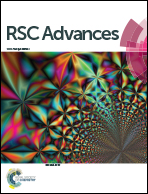A novel colorimetric and fluorescent probe based on a core-extended perylene tetra-(alkoxycarbonyl) derivative for the selective sensing of fluoride ions†
Abstract
A novel fluoride (F−) colorimetric and fluorescent probe (P1) based on a core-extended perylene tetra-(alkoxycarbonyl) (PTAC) derivative was developed. The probe exhibited high sensitivity and selectivity for distinguishing F− from other common anions through significant changes of the UV-Vis and fluorescence spectra. Job's plot analysis revealed that the stoichiometry of the P1–F− interaction is 1 : 1. The association constant between P1 and F− was estimated to be 9.7 × 102 M−1 and the detection limit of F− was about 0.97 μM. An approximately 76 nm red-shift in the absorption and fluorescent quenching response was observed when F− was associated with P1. The emission intensity (I574) decreased linearly along with the F− concentration from 3 × 10−5 M to 2 × 10−4 M. The mechanism of intermolecular proton transfer (IPT) was deduced based on the changes in the absorption, fluorescence, electrochemistry, and 1H NMR titration spectra. The density functional theory (DFT) theoretical results of the P1–F− complex are in good agreement with the experimental results. The rapid detection of F− ions in the solid state and living cells was also studied.



 Please wait while we load your content...
Please wait while we load your content...